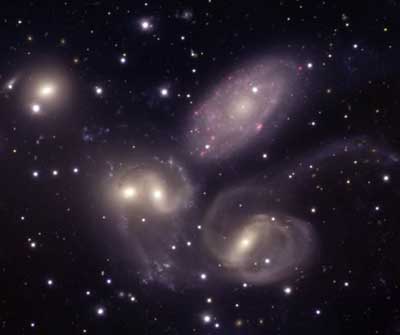The Gemini Observatory took a spectacular picture of a cluster of galaxies known as Steven's Quintet
Press release on behalf of Mitzpe Gemini

The Gemini Observatory published a breathtaking image of a galactic ballet dance, taking place on a stage about 300 million light years away.
The galaxies, members of a famous band called the "Steven Quintet", practically tear each other apart. Their shapes are shaped by gravitational interactions, which occur over millions of years. Drifting arcs of gas and dust tell the stories of these interactions and sometimes also transits of the galaxies within each other. The ongoing dance distorted the shape of the galaxies and created a prolific fireworks display of star formation, fueled by clouds of hydrogen, which were compressed to form maternity homes for the stars.
The first image of its kind of the cluster provides a rare combination of sensitivity, high resolution and a wide field of view. "It doesn't take long to get that deep, when you have an eight-meter mirror that collects light in excellent conditions," said Travis Rector of the University of Alaska, who helped produce the image with the Gemini Telescope on Mauna Key. "We were able to photograph the galaxies in many wavelengths (or colors). In this way, we were able to refine various details and reach the quality of a counter, which has never been seen before."
An amazing element in the image is the presence of bright red dots, which symbolize the star formation regions in the galaxy, called NGC 7320. Although its relationship to the other galaxies in the cluster is a matter of controversy, most astronomers believe that this galaxy leads a relatively peaceful life, far from the struggles taking place in the cluster.
Spectroscopic data show that NGC 7320 has an apparent speed away from us of about 800 kilometers per second. The rest of the group, however, is being carried away from us courtesy of the universe's expansion at about 6,000 kilometers per second. According to current models of the expansion of the universe, this means that the center of the cluster is 8 times farther away from us than NGC 7320.
The bright red patches scattered along the spiral arms of NGC 7320 in the new image of Gemini provide a clear illustration of the effect of the galaxies' apparent velocities on the image we see. In NGC 7320 and the rest of the galaxies there are regions of intense star formation, which can be detected by glowing clouds of hydrogen, called HII regions. These areas look especially red, because a special filter was used, which transmits a certain color of red light, called alpha red. The alpha red is produced in the HII regions. Among the faster cluster members there are HII regions around the two central galaxies, but they do not appear in red in the image. The reason for this lies in hist Doppler. The glow emanating from the HII regions was redshifted beyond the range of the specific filter, and therefore did not appear distinctly red.
The active companies in the Steven's Quintet will probably continue in their gravitational dance for millions more years. Eventually, the dance will most likely cause some of the galaxies in the cluster to completely lose their current identity and blend in, so that there will be even fewer objects than today.
Stephen's quintet was discovered in 1877 by the French astronomer Edward Stephen (Stephan) from the Marseille Observatory. The cluster is cataloged in the Hixon Compact Group catalog as number 92. It has been studied in depth at all wavelengths, including images from the Hubble Space Telescope. Recent Gemini observations of star cluster formation near the Stephen Quintet can be found Dikla Oren
